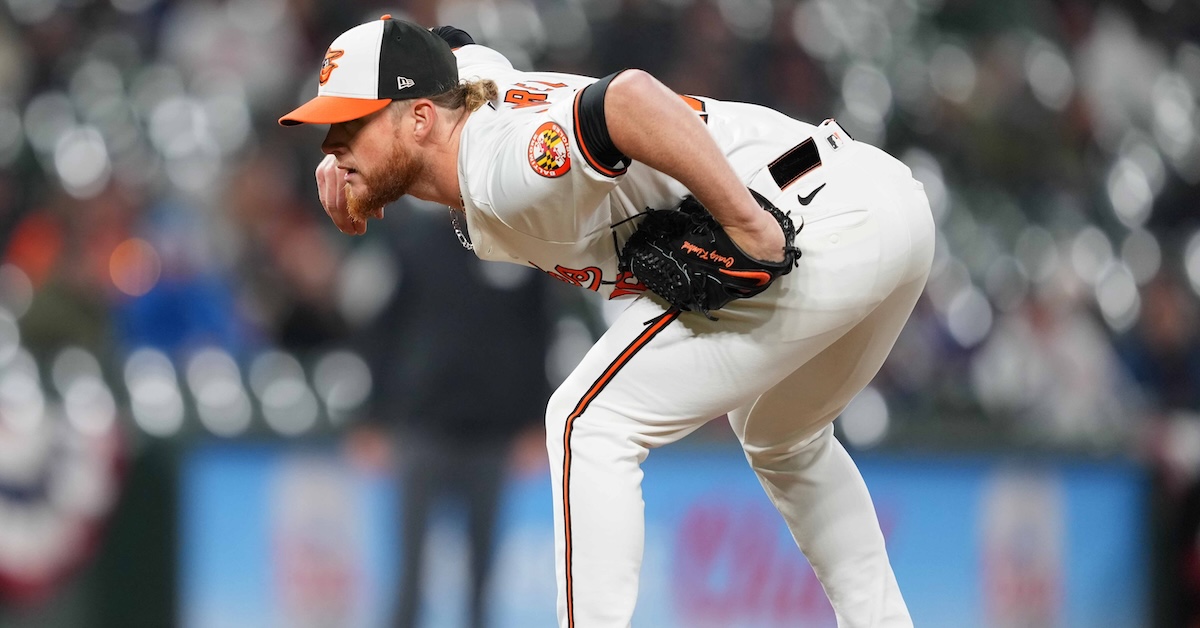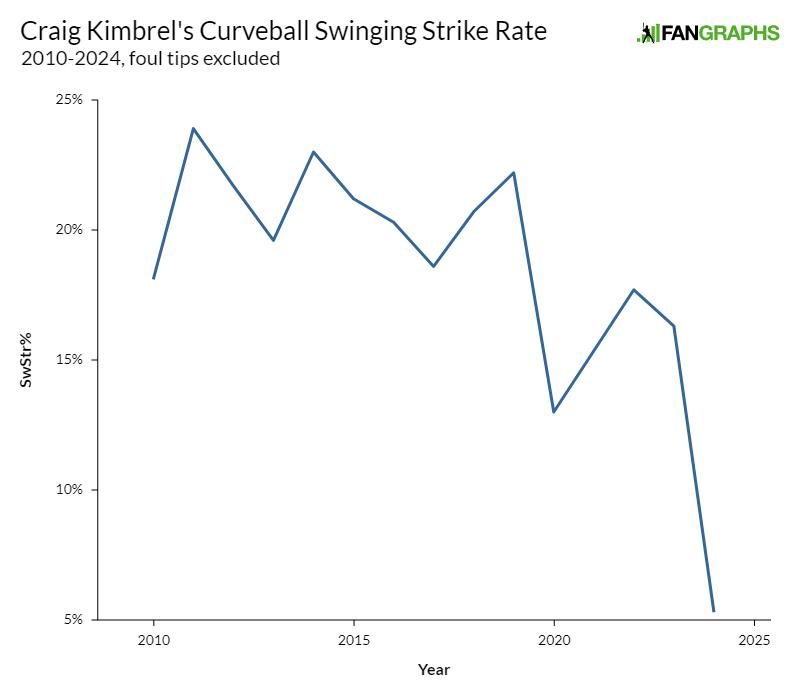
Mitch Stringer-USA TODAY Sports
For four years, Craig Kimbrel was the best reliever in baseball. He wasn’t arguably the best reliever in baseball, or tied for the best; he was just the best. From 2011 through 2014, he compiled a 1.51 ERA with a 1.52 FIP. He struck out 42% of opposing hitters. He allowed a measly .269 BABIP, and didn’t give up home runs either. He averaged more than 65 innings a year and racked up 185 saves as the foregone conclusion of any game that Atlanta led going into the ninth inning.
For the next four years, he was merely a very good reliever – 2.47 ERA, 2.49 FIP, 41% strikeout rate. He started walking more batters and allowing more home runs. He was 30 years old in 2018, and the path forward felt murky. He signed with the Cubs in June of 2019 after a qualifying offer depressed his market, and he was downright abysmal. In 2019 and 2020 combined, he racked up a 6.00 ERA, a 6.29 FIP, and a ghastly 14.6% walk rate to go with 2.75 homers per nine innings. You know the story arc from there, more or less; that run signaled the end of his dominance, and even with occasional flashes of brilliance in the intervening three years, he was back to just a nice arm instead of an unconquerable monster.
I’ve always been interested in the idea of a Craig Kimbrel retrospective, because at his peak he felt so different from the rest of the league, with the wild strikeout rates and the misprint-looking ERA. Mariano Rivera never had a four-year stretch as good as Kimbrel’s, even though he obviously had far greater longevity. I can’t remember who invented it, but Kimbrel even inspired a new junk statistic: a Kimbrel is a game where a pitcher records a negative FIP. That was his specialty; it requires at least two strikeouts, no walks, and no homers over an inning of work. Games like that just felt inevitable at his best.
I’ve been waiting to write that retrospective for a while, because Kimbrel is still a valuable bullpen piece. But he hasn’t felt like a truly elite closer in quite a while. He got off to a blistering start in 2021, but faded hard down the stretch. He was just another guy with the Dodgers and Phillies the last two years. Sure, he was a closer, but he wasn’t a capital-C Closer. By the postseason last year, he looked downright unreliable. The path towards retirement couldn’t take that much longer, right?
Well, it looks like I might have been a bit too hasty! Kimbrel has only thrown seven innings this year, but they’ve been phenomenally impressive innings. He’s faced 24 batters and struck out 13 of them. He hasn’t walked anyone. He’s allowed just three hits, all singles. Forget a Kimbrel game – he has a negative FIP on the season.
Obviously, he’s not going to keep this dominance going. But I thought I’d look into what has gone right for him so far – in a tiny sample, of course – in Baltimore. Maybe the O’s have figured something out. Maybe he’s been rejuvenated in a new situation. Or maybe it’s just a hot streak. Regardless, I want to know, because this sudden spike back into prominence is turning my understanding of his career arc upside down.
Here’s a confusing indicator:

That’s right: Kimbrel is missing bats less frequently than ever before in his career. The culprit? His curveball, which is putting up a career-low swinging strike rate by a comical margin:

That’s his signature pitch, the two-strike hammer that made him so untouchable at his peak. Now, it seems declawed. Batters simply aren’t swinging at it. They’re also making more contact. Put the two together, and you get a breaking pitch with swinging strike numbers like a marginal sinker. Have hitters solved Kimbrel?
I mean, obviously not. This article is about how his FIP is negative so far this year, remember? Here’s Rowdy Tellez watching doom loop towards him at 83 mph and giving up on it – twice:
Here’s Sal Frelick identifying spin – and taking a slow walk back to the dugout as a result:
Kimbrel is even using the pitch to sneak back into the count:
I don’t think this usage pattern is sustainable. Batters have made contact with all three in-zone curves they’ve offered at, and they’ve hit two of them over 100 mph, albeit on the ground. But they’re just not swinging enough, and those free strikes have pushed Kimbrel’s called strike rate up near a career high. The only time he drew more called strikes was in 2020, when he walked 17.4% of opposing batters. Plenty of those called strikes came with hitters way ahead in the count and giving Kimbrel the space to bury himself. This time, they’re taking from disadvantageous starting positions too.
Will this plan work over a full season? I don’t really think so. Hitters are eventually going to start swinging at the curveball at a reasonable rate, and I’m not convinced that its shape will bail him out when they do. It’s not quite the same grim reaper that it was at his peak. He’s never had one consistent curveball shape, but he’s throwing it with more sweep and less drop these days:
Craig Kimbrel, Curveball Velo and Movement
| Year |
Velo (mph) |
HMov (in) |
VMov (in) |
| 2010 |
84.7 |
5.9 |
-6.7 |
| 2011 |
86.8 |
4.8 |
-6.7 |
| 2012 |
85.7 |
6.1 |
-7.2 |
| 2013 |
85.8 |
5.7 |
-7.0 |
| 2014 |
85.3 |
4.9 |
-6.2 |
| 2015 |
86.7 |
5.8 |
-6.0 |
| 2016 |
86.6 |
5.9 |
-6.4 |
| 2017 |
87.3 |
4.2 |
-5.2 |
| 2018 |
86.6 |
5.0 |
-4.4 |
| 2019 |
85.9 |
4.0 |
-4.4 |
| 2020 |
86.0 |
5.3 |
-3.8 |
| 2021 |
86.1 |
5.0 |
-3.1 |
| 2022 |
85.7 |
4.8 |
-3.8 |
| 2023 |
86.1 |
4.8 |
-5.0 |
| 2024 |
84.2 |
6.2 |
-3.9 |
To be fair, our pitching models still like it quite a lot. They’re still into his fastball, too, even though it’s lost a few ticks from its peak. It turns out that the plan of throwing a fastball with great shape high in the zone and snapping off a big-movement curveball below it still plays even if Kimbrel can’t execute quite as well as he did early in his career. I just don’t think he’ll continue to bamboozle hitters into leaving their bat on their shoulders. That will probably come with more swinging strikes, but it will inevitably come with some loud contact as well. Right now, his plan is perfect, but the other side will inevitably make adjustments. They’ll have to; he’s just been too good to ignore.
With all this hype, can you guess who leads the majors in Kimbrels this year? That’s right… it’s Adam Ottavino:
2024 Kimbrels Leaderboard
But Kimbrel is tied with him, and I only put him second for comedic purposes. He’s been ridiculous. The only run he allowed came on one of those fluke sequences that happen to every pitcher from time to time: single, steal, steal, sacrifice fly. The other two batters to make outs in that inning? Strikeouts, naturally. He’s just on a roll right now.
Will this be enough to get Kimbrel into the Hall of Fame one day? That’s more of a question for my colleague Jay Jaffe, but I think he’s got a solid case. The career numbers are piling up. A 2.39 ERA over 764 career innings works out to a 58 ERA-. That’s the third-best mark by any pitcher with at least 750 innings; only Rivera and Billy Wagner were better. He’s top 10 all-time in K/9+, and second in unadjusted strikeout rate behind only Aroldis Chapman. He’s eighth in career saves and climbing. Craig Kimbrel is back – and it has reminded me that when it’s all said and done, he’s going to go down in history as one of the best.
Source
https://blogs.fangraphs.com/call-him-butter-because-craig-kimbrel-is-on-a-roll/
 Backyard GrillingWeekend WarriorsAdvice from DadBeard GroomingTV Shows for Guys4x4 Off-Road CarsMens FashionSports NewsAncient Archeology World NewsPrivacy PolicyTerms And Conditions
Backyard GrillingWeekend WarriorsAdvice from DadBeard GroomingTV Shows for Guys4x4 Off-Road CarsMens FashionSports NewsAncient Archeology World NewsPrivacy PolicyTerms And Conditions
